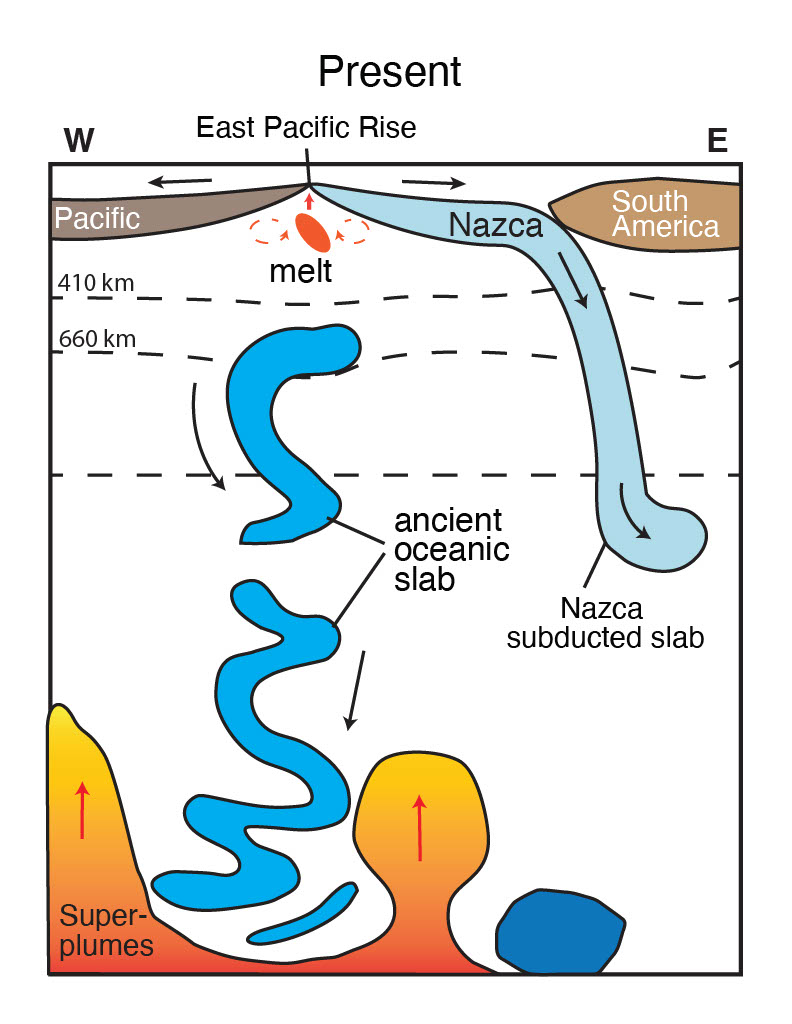When the dinosaurs dominated the Earth, a piece of seafloor west of South America was drawn into the mantle as another crust rode over it. Curiously, it has survived despite oceanic plates of the same age usually having been recycled into the mantle, suggesting we need to tweak our understanding of Earth’s interior.
The floor of the ocean is constantly being produced at mid-oceanic ridges, which means it also needs to be constantly destroyed. This process happens at subduction zones, when continental plates ride over ocean plates, forcing them into the Earth’s mantle where they are thought to persist for a while before gradually dissolving.
However, when a team led by Dr Jingchuan Wang of the University of Maryland used a new seismic technique to study the mantle’s structure beneath the eastern Pacific, they found something unexpected in the waves reflected back to them. Where the upper and lower mantle meet is an area known as the mantle transition zone. Off South America, Wang and colleagues found evidence the transition zone is unusually thick – stretching from 410 to 660 kilometers (250-400 miles) beneath the sea floor.
“This thickened area is like a fossilized fingerprint of an ancient piece of seafloor that subducted into the Earth approximately 250 million years ago,” Wang said in a statement. “It’s giving us a glimpse into Earth’s past that we’ve never had before.”
The subduction is thought to have continued until around 120 million years ago, and lies under the Nazca Plate, but is thought to be from a previous subduction event.
Normally, a plate would be expected to have been recycled into the mantle after this long, but the authors think about 14 percent of the original slab volume survives.
“We found that in this region, the material was sinking at about half the speed we expected, which suggests that the mantle transition zone can act like a barrier and slow down the movement of material through the Earth,” Wang continued. “Our discovery opens up new questions about how the deep Earth influences what we see on the surface across vast distances and timescales.”
The discovery was made because the team deployed a new, more advanced method of seismic imaging to understand what is happening within the mantle. “You can think of seismic imaging as something similar to a CT scan. It’s basically allowed us to have a cross-sectional view of our planet’s insides,” Wang said.

The Nazca Plate is being subducted beneath South America, but near its other boundary is the remnant of an ancient plate that started subducting in the Triassic, which has survived thanks to resistance at the mantle transition zone
Image Credit: Jingchuan Wang
Two big questions from the finding are how unusual this slow sinking is, and what effects it has on plate behavior above, where it matters most to us. The team’s explanation for the transition zone’s resistance is that it is unusually cool in this area, relatively speaking, but only by replicating the study elsewhere will we learn if other cool spots exist.
Certainly, the slowness of the sinking of the old plate has not translated to any tardiness at the surface. Instead, the East Pacific Rise is the fastest-spreading ocean ridge in the world.
In the meantime, the team wants to explore the relationship between the slab’s survival and the Pacific Large Low Shear Velocity Province (LLSVP), an enormous area of the lower mantle bisected by the slab. This is the counterpart of another enormous low-shear-velocity region under Africa, but is more poorly mapped. The subducted plate explains a gap within the LLSVP that had previously been detected, but not understood.
Even if the team doesn’t find another slowly sinking slab, Wang is confident the more advanced seismic imaging will change mantle research. “This is just the beginning,” he said. “We believe that there are many more ancient structures waiting to be discovered in Earth’s deep interior. Each one has the potential to reveal many new insights about our planet’s complex past—and even lead to a better understanding of other planets beyond ours.”
The study is published open access in the journal Science Advances.
Source Link: A Surviving Remnant Of Dinosaur-Era Tectonic Plate Rewrites Mantle Behavior